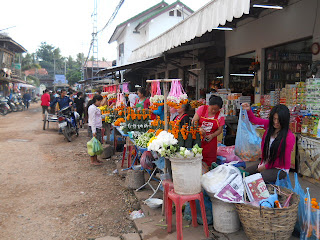 This morning my Vietnamese hostel mate,Cuong decided to visit the Buddha Park so I accompanied him to the Vientiane Bus Terminal near Talat Sao to catch Bus No:14.
This morning my Vietnamese hostel mate,Cuong decided to visit the Buddha Park so I accompanied him to the Vientiane Bus Terminal near Talat Sao to catch Bus No:14.Cuong has his last day itinerary as he'll be catching the 5:00pm sleeper bus (150,000 kips)to Vinh in Central Vietnam.
He's the staff of Vietnam Telecom in Ho Chi Minh City.

We walked from Sabaidee Guesthouse at Setthathirah Road to the bus station which takes about 15 minutes.
It was a non aircond local minibus and the fare was 6,000 Lao Kips.
Interestingly the minibus do stop at the Lao Immigration before the Firendship Bridge to NongKhai town in Thailand.
Bus passengers destined to Thailand will disembark from here and later the bus continued to pick up passengers at a bus stop in front of the shops nearby. Those who just came in from NongKhai ,Thailand should make sure whether the bus is heading to Vientiane otherwise you'll be paying for a roundtrip.

Buddha Park also known as Xiengkuane Buddha Park is about 25km southeast from Vientiane City and it lies just beside the mighty Mekong River with a good view of Nongkhai town across the river.
Part of the main road before the park has a lot of potholes so expect to enjoy the bumps.
The entrance fee to Buddha Park is 5,000 Kips and 3,000 kips if you declared your camera.
The first interesting sight is a sculpture that looks like a Lao pumpkin with a stalk on the top.
Orange colour pumpkins in abundance were quite popularly sold at the wet market behind Vientiane bus terminal.
Orange is the colour of the monk's robe and the pumpkin must be part of the vegetarian menu as it was rich in nutrients beta carotene for health longetivity.
The early days sculptors must have been inspired by this heavenly fruit.
To the Chinese,pumpkin (南瓜; nánguā) symbolises - prosperity, abundance, descendant's luck, illustrious children, enchantment, fruit draws earth energy to manifest gold.
Whereas to our western counterparts,Pumpkins and Halloween go together like candy and apples, and this orange globe can light up this frighteningly fun occasion.
Big mouth is awaiting visitors into this heavenly fruit. It will be hell when entering but if you manged to reach the apex it will be like heaven. This structure is facing beside a slow flowing Mekong River.
In Geomancy(feng shui) terms,this will be good 'Chi' or 'the breath of life'
Buddha has disciples like Ananda,Asoka,Mahinda,Nanda and many others who are Hindu origin.
Asoka is the most famous Indian emperor who converted to Buddhism after learning The Dharmma in the 273 BCE .
Thereafter wars were banned. He was a lay Buddhist who contribute the expansion of Buddhism in India and Sri Lanka (Ceylon) by sending his children to preach the Dhamma.
A large sculpture of Reclining Buddha.
Left arm along the body, right arm serves as a pillow with the hand supporting the head.
Story : The giant Asurindarahu wanted to see the Buddha, but was reluctant to bow before him. The Buddha, while lying down, presented himself as much larger than the giant.
He then showed him the realm of heaven with heavenly figures all larger than the giant.
After all this, Asurindarahu, the giant, was humbled, and made his obeisance to the Buddha before leaving.
These images of Buddha in similar postures can be seen in Thailand at the following places:- [at Phra Pathom Chedi, Nakhon Pathom province],[Wat Imprumoon, Ang Thong province] and [Wat Pho near Bangkok].

Hindu Goddess Durga sculpture.
The Destroyer of Evil.
Four Headed Lord Brahma who has been cursed by Lord Shiva.
Three Headed Elephant similar to the Erawan Shrine Statue at Paknam in Samut Prakan Province,Thailand.
Hindu God Ganesha has an elephant head in a human body.



 Demon statue that looks alike the one guarding the Hor Phra Monthien Dharma, Wat Phra Kaew, Grand Palace, Bangkok, Thailand.
Demon statue that looks alike the one guarding the Hor Phra Monthien Dharma, Wat Phra Kaew, Grand Palace, Bangkok, Thailand. 
Apart from tourists,monks also came to visit as part of their field work.
Laotian boy from the nearby neighbourhood playing at the park.
Grasshoppers and locusts are enemies that threatened the livelihood of the peasants and farmers.
Statue of Buddha shielded by serpents.

A panoramic view of Buddha Park from the apex of the 'pumpkin'.






























